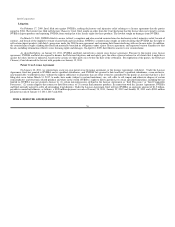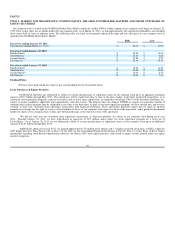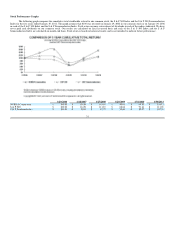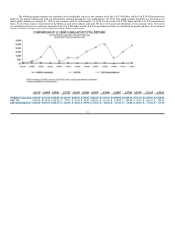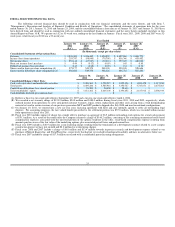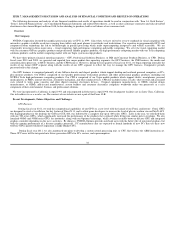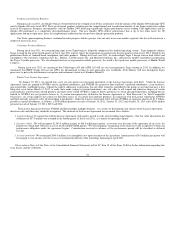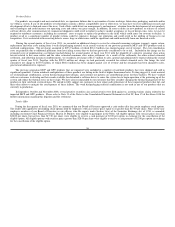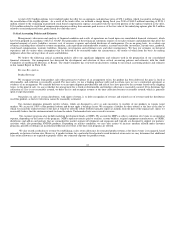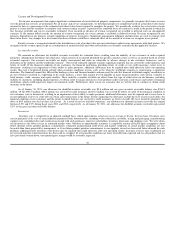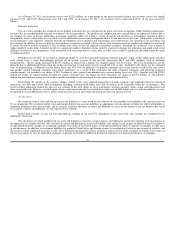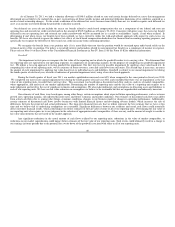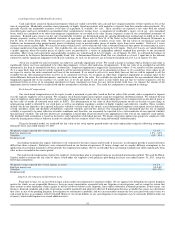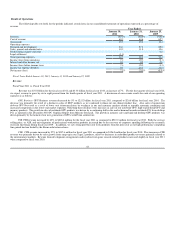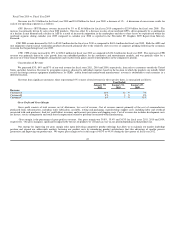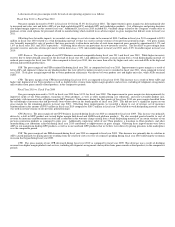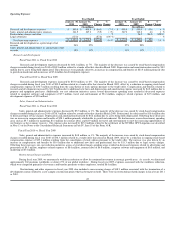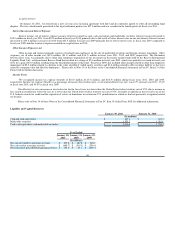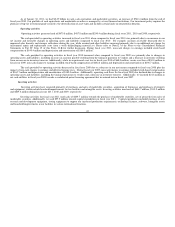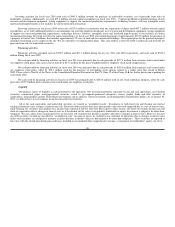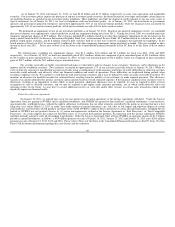NVIDIA 2011 Annual Report Download - page 41
Download and view the complete annual report
Please find page 41 of the 2011 NVIDIA annual report below. You can navigate through the pages in the report by either clicking on the pages listed below, or by using the keyword search tool below to find specific information within the annual report.
As of January 30, 2011, our inventory reserve was $152.0 million. As a percentage of our gross inventory balance, our inventory reserve has ranged
between 15.0% and 30.6% during fiscal years 2011 and 2010. As of January 30, 2011, our inventory reserve represented 30.6% of our gross inventory
balance.
Warranty Liabilities
Cost of revenue includes the estimated cost of product warranties that are calculated at the point of revenue recognition. Under limited circumstances,
we may offer an extended limited warranty to customers for certain products. Our products are complex and may contain defects or experience failures due to
any number of issues in design, fabrication, packaging, materials and/or use within a system. If any of our products or technologies contains a defect,
compatibility issue or other error, we may have to invest additional research and development efforts to find and correct the issue. Such efforts could divert
our management’s and engineers’ attention from the development of new products and technologies and could increase our operating costs and reduce our
gross margin. In addition, an error or defect in new products or releases or related software drivers after commencement of commercial shipments could result
in failure to achieve market acceptance or loss of design wins. Also, we may be required to reimburse customers, including our customers’ costs to repair or
replace products in the field. A product recall or a significant number of product returns could be expensive, damage our reputation and could result in the
shifting of business to our competitors. Costs associated with correcting defects, errors, bugs or other issues could be significant and could materially harm
our financial results.
During fiscal year 2011, we recorded an additional charge to cover the estimated remaining customer warranty, repair, return, replacement and other
costs arising from a weak die/packaging material set in certain versions of our previous generation MCP and GPU products used in notebook
configurations. The net charge amounted to $193.9 million, of which $181.2 million was charged against cost of revenue. The extra remediation costs are
primarily due to additional platforms from late failing systems that we had not previously considered to be at risk. Included in the charge are the estimated
costs of implementing a settlement reached during fiscal year 2011 with the plaintiffs of a putative consumer class action lawsuit related to this same matter
and another related estimated consumer class action settlement. As a result of this settlement, the other estimated settlement, and offsetting insurance
reimbursements, we recorded a net charge of $12.7 million to sales, general and administrative expense during fiscal year 2011. Together with the $282.0
million net charge we had previously recorded for related estimated costs, this brings the total cumulative net charge to $475.9 million, of which $466.4
million has been charged against cost of revenue and the remainder has been charged to sales, general and administrative.
Determining the amount of the warranty charges related to this issue required management to make estimates and judgments based on historical
experience, test data and various other assumptions including estimated field failure rates that we believe to be reasonable under the circumstances. The
results of these judgments formed the basis for our estimate of the total charge to cover anticipated customer warranty, repair, return and replacement and
other associated costs. However, if actual repair, return, replacement and other associated costs and/or actual field failure rates exceed our estimates, we may
be required to record additional reserves, which would increase our cost of revenue and materially harm our financial results.
Income Taxes
We recognize federal, state and foreign current tax liabilities or assets based on our estimate of taxes payable or refundable in the current fiscal year
by tax jurisdiction. We recognize federal, state and foreign deferred tax assets or liabilities, as appropriate, for our estimate of future tax effects attributable to
temporary differences and carryforwards; and we record a valuation allowance to reduce any deferred tax assets by the amount of any tax benefits that, based
on available evidence and judgment, are not expected to be realized.
United States income tax has not been provided on earnings of our non-U.S. subsidiaries to the extent that such earnings are considered to be
indefinitely reinvested.
Our calculation of current and deferred tax assets and liabilities is based on certain estimates and judgments and involves dealing with uncertainties in
the application of complex tax laws. Our estimates of current and deferred tax assets and liabilities may change based, in part, on added certainty or finality to
an anticipated outcome, changes in accounting standards or tax laws in the United States, or foreign jurisdictions where we operate, or changes in other facts
or circumstances. In addition, we recognize liabilities for potential United States and foreign income tax contingencies based on our estimate of whether, and
the extent to which, additional taxes may be due. If we determine that payment of these amounts is unnecessary or if the recorded tax liability is less than our
current assessment, we may be required to recognize an income tax benefit or additional income tax expense in our financial statements, accordingly.
39


